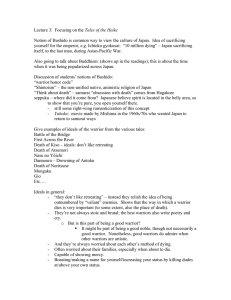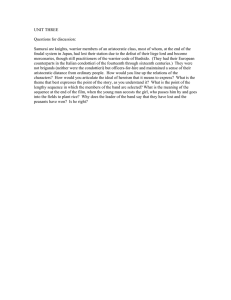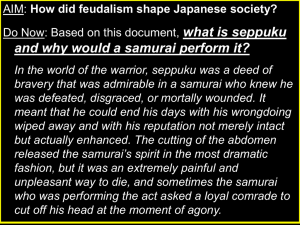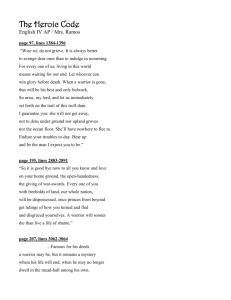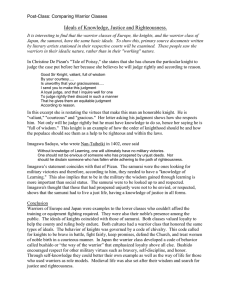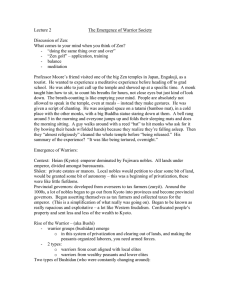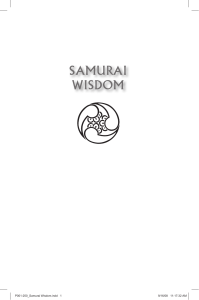Lecture 1 Introduction Medieval period: 1185-1867
advertisement
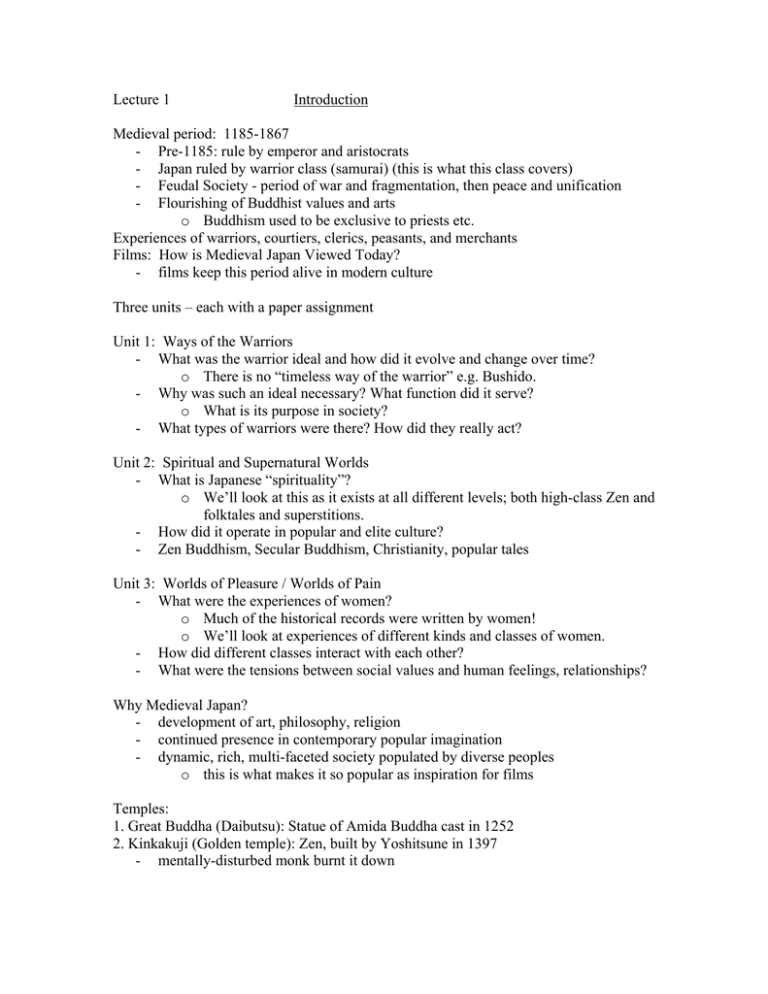
Lecture 1 Introduction Medieval period: 1185-1867 - Pre-1185: rule by emperor and aristocrats - Japan ruled by warrior class (samurai) (this is what this class covers) - Feudal Society - period of war and fragmentation, then peace and unification - Flourishing of Buddhist values and arts o Buddhism used to be exclusive to priests etc. Experiences of warriors, courtiers, clerics, peasants, and merchants Films: How is Medieval Japan Viewed Today? - films keep this period alive in modern culture Three units – each with a paper assignment Unit 1: Ways of the Warriors - What was the warrior ideal and how did it evolve and change over time? o There is no “timeless way of the warrior” e.g. Bushido. - Why was such an ideal necessary? What function did it serve? o What is its purpose in society? - What types of warriors were there? How did they really act? Unit 2: Spiritual and Supernatural Worlds - What is Japanese “spirituality”? o We’ll look at this as it exists at all different levels; both high-class Zen and folktales and superstitions. - How did it operate in popular and elite culture? - Zen Buddhism, Secular Buddhism, Christianity, popular tales Unit 3: Worlds of Pleasure / Worlds of Pain - What were the experiences of women? o Much of the historical records were written by women! o We’ll look at experiences of different kinds and classes of women. - How did different classes interact with each other? - What were the tensions between social values and human feelings, relationships? Why Medieval Japan? - development of art, philosophy, religion - continued presence in contemporary popular imagination - dynamic, rich, multi-faceted society populated by diverse peoples o this is what makes it so popular as inspiration for films Temples: 1. Great Buddha (Daibutsu): Statue of Amida Buddha cast in 1252 2. Kinkakuji (Golden temple): Zen, built by Yoshitsune in 1397 - mentally-disturbed monk burnt it down Zen Gardens: Daisen-in Garden (Kyoto): Built in 1509 by Soami Ryoanji (Temple of the Peaceful Dragon) Noh/Kabuki - Noh is much more ritualistic than Kabuki, which is more popular-culture. - Kabuki was at first done by women in front of brothels o Then the government banned women from doing this, so it became allmale Bunraku (puppet theater) - each doll has 3 people operating it (unhooded operator does head and right arm, hooded operators do left arm and legs) Tea Ceremony (Chanoyu) - art of serving/preparing tea “with a pure heart” - became something you do among upper ruling warriors while they’re making decisions or having serious conversation Mito Kômon is an example of Jidai geki - Jidai geki: popular TV shows about this period. Each show happens exactly the same way: the main character reveals corrupt officials, beats on them, reveals who he is, causing their immediate surrender; he corrects the problem, laughs, and walks away Abarenbô Shogun (“Rowdy Boy Shogun”): another TV show: poor son of a samurai retainer. Corrects injustices, etc. Anime: Samurai 7: anime based on Seven Samurai by Kurosawa Afro Samurai: Samuel L. Jackson is going to voice-act this one Films for Unit 1: (see syllabus) Recommended: Throne of Blood (Kurosawa, 1957) – will not be screened Geography, 1185-1600 Basically, you can divide Japan between East and West. Japan wasn’t very unified; the people in the East were more of a horse-riding, plains-type culture, and they spoke a different dialect. West regions were more maritime; pirates, traders, etc. Sanyodô was main roadway; to give an idea of its size: the roads fit 2 horses. Main region is Kinai – “cradle of Japanese civilization;” it’s where the capital, Kyoto, was and where Nara, the Buddhist center, was; Kinai had 2 million people. Important lake: Biwa Lake – allows trade by connecting this part of Japan to the ocean. The different regions are very important. Kanto region: this is where the warrior culture flourishes. Heavily agricultural. Warriors were mostly horse+bow+arrow and very rich, due to the agriculture. Hokkaido was referred to as Ezo; there was some limited trade with it. Trade between Korea and farther eastern region. The next map on the slides is a provincial map of Japan from Kamakura period; don’t need to memorize it. Now onto the reading for next week: Tales of the Heike: very popular in Japan, “every schoolchild knows this.” Slide outlines the story. - Note for this book: in this era, there was something called the “cloistered emperor” and the actual emperor. - There are “hundreds and hundreds” of characters in this book. - There’s a point that might be confusing: once Yoshinaka takes Kyoto, power goes to his head and he becomes independent, and forms his own party. It’s part of a genre called “warrior tales.” These tales were originally not written but sung by wandering blind minstrels called biwa hôshi; blindness indicated special spiritual powers. There were hundreds of versions due to embellishments and variations in how they were sung/told by the biwa hôshi. Finally a definitive version was written down. There will be a character glossary.
